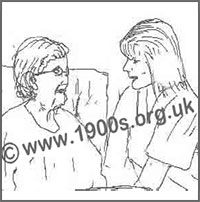Conversation starters with the elderly and dementia sufferers

Starting a conversation with someone elderly or with dementia can be quite difficult. You want a two-way conversation but, all too often, you find that you are doing all the talking. There is a way to help that has proved very successful. It uses old photographs to trigger memories from the person's youth when their memories and interests were at their peak. This page describes tried and test ways of achieving good results.
____
By the webmaster based on considerable experience and discussions with others
What content of photos best trigger memories and conversation?
Old people and people with failing memory like to talk about the past. So photographs of places or people that they once knew are ideal for bringing back a flood of reminiscences and be the start of avid conversation. However, depending on the infirmity of the person, concerned, it is likely that they will need time to get their mind into focus. So take along a collection of photos. You'll see the importance of this as you read on.
What is the ideal format for the photos?
The main problem with photos, particularly old ones, is that they tend to be too small to be examined closely by anyone with failing eyesight, and the light may not be good anyway. So there is significant value in having the photos as images on a tablet or portable computer. The images can be made full-screen, and computers and laptops have their own light.
A tablet is ideal because it is sufficiently lightweight to be held easily or rested on a cushion close to the person.
Don't give up though on laptop displays, family photograph albums or sheaves of loose photos.
How to show the photos for best results
There is a technique for using the photos to best effect.
I and others who were interested in our family history found that the best way to start was to show just one photo, and say something like, "I thought you might like to see this". Perhaps also say a few words about it.
Wait awhile, keeping the first photo in view. Do not rush. If the individual does start reacting, just nod encouragingly and wait for more to come.
Wait in silence for some moments for the person to gather their thoughts, and then ask a question, like, "Do you remember this?" or "Where was this?" or "Who is it in this photo?"
If you are lucky, this alone will generate a flood of reminiscences and be the start of avid conversation. More likely, though, the response, if any, will be "Hmm" or "Don't remember".
This why you need a collection of photos rather than a single one.
Move to the next photo or put the paper version at the back of the 'pack'. Take your time, relax and take care not to be too intense as this could make the person feel under attack. Keep repeating the process in a relaxed way as if time didn't matter. Yes, it does mean showing the same photos several times, but show them as if they are new ones.
As the person gets their mind in focus, reactions may start coming. Our experience is that the they often start responding with more details even though there was no reaction at all first time round!
If you don't have suitable photos - this website can help
The website is packed with recollections from ordinary people who lived in the early-mid 20th century, and it contains their photographs and photographs from museums. It thus relates to times when elderly people were living their lives to the full - and of course, you can access these photos directly on a tablet or portable computer free of charge. So there is no need to use your own photos.
Where to start? Well, it will be best if you know something about the person's life. Did they, they parents or friends, for example, ever live in an old Victorian house or a 1930s/40s suburban house; were they air raid wardens or in the Home Guard in the Second World War; did they use air raid shelters or gas masks; or cook with old kitchen utensils; or watch their mothers do the weekly wash; or travel by steam train? For even more ideas, see the above ALL TOPICS link or search box link to see if something you particularly want is illustrated or discussed somewhere.
The quizzes can also be a quick and effective way in.
The value of old photos with mild dementia sufferers
A TV programme reported that 'mini rooms' of furnishings from a few decades ago had been bought by the NHS for use with dementia sufferers. The idea was that as dementia sufferers' early memories are better than their short-term ones, the 'rooms' would stimulate them to think about their past. So if a 'room', then why not pictures? This website is packed with pictures from a few decades ago. Furthermore, it is available without charge anywhere where there is internet access.
Although using the website as described here is tried and tested for stimulating conversation with the elderly, its use with dementia sufferers is, as yet, only a plausible idea. So if you do try using the website with someone with mild dementia, I would be grateful for you to contact me with your experience.
Good luck!
| sources | webmaster | contact |
Text and images are copyright
If you can add anything to this page or provide a photo, please contact me.



